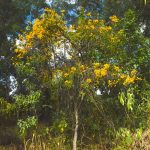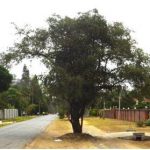TREE LIFE
August/September 2019
MASHONALAND CALENDAR
Saturday 7th September: Botanic Garden Walk. Meet in the car park at 8.30am. Hope to see you there, this walk should last about an hour and a half.
Sunday 15th September: Lake Chivero National Park.
Saturday 27th July: Alexandra Park.
TREE OF THE MONTH – Erythrina abyssinica
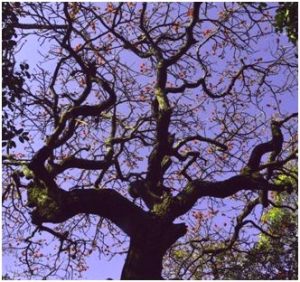
Erythrina-abyssinica. Photo: Ryan Truscott
Our Tree of the Month is a source of delight both to humans and to giraffes. For me, the spectacular flowering of the Lucky-bean tree, Erythrina abyssinica, has always been a sign that winter is coming to an end.
The tree gets its specific name from Abyssinia (now Ethiopia) where it was first collected for science. My wife and I liked the tree and the name so much that we called one of our cats Abyssinica. His name was prophetic as he developed a temperament as prickly as the underside of an Erythrina leaf.
But there are no leaves on the tree in July/August. Instead, the crown is covered in scarlet flowers, and the bareness of the branches enhances the spectacle.
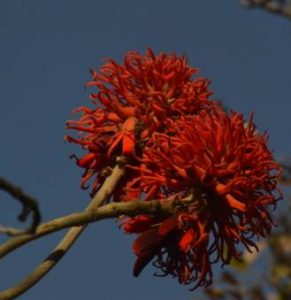
Erythrina abyssinica flowers. Photo: Ryan Truscott
The tree in flower is a splash of scarlet against the gold and browns of winter, providing much-needed forage for birds. In fact, Erythrina species are recommended if you’re wanting to attract sunbirds and other avifauna to your garden.
In July I took a mid-day walk in Harare’s Haka Game Park. Hardly a bird moved in the dry woodland, so I decided to take a look at one of the many E. abyssinica trees dotted around the park. As I approached the tree, I heard a rustle in the branches. What I thought was a monkey turned out to be a giraffe, pulling great mouthfuls of flowers off the branches. That got me wondering: is there an established relationship between giraffes and Erythrina trees, as there is with Acacias?
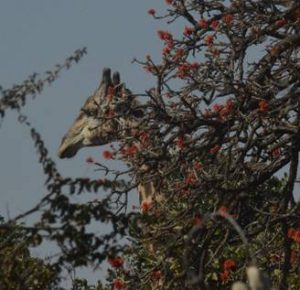
Giraffe browsing on Erythrina abyssinica flowers. Photo: Ryan Truscott
An interesting study was done in the Kruger National Park over 10 years ago. Researchers there wanted to see if giraffes aided pollination by foraging on the flowers of the Knob thorn, Acacia nigrescens. The upshot was: no they don’t. The giraffes were more destructive than helpful to the trees. Maybe that’s why the giraffe I saw in Haka, helping itself to Erythrina flowers, looked as guilty as a boy caught stealing wine gums in a sweet shop.
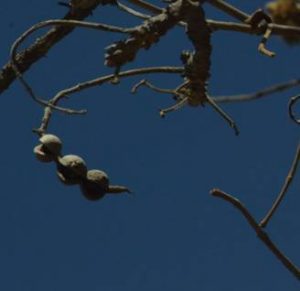
Erythrina abyssinica seeds. Photo: Ryan Truscott
I asked local botanist Fay Robertson if she knew of any relationship between the giraffe and the Erythrina. She said she wasn’t aware of any. But she did say the animals do not occur naturally on the highveld, and the one I saw was likely feeding on the flowers in the absence of its normal “high quality” Acacia food. Flowers often have more nutrients than leaves, especially at this time of the year, she said, noting that she’d even seen the Haka giraffe chewing on the stones of Mobola plums, Parinari curatellifolia.
The flowers aren’t the only distinctive feature of E. abyssinica. There are those knobbly pods, though few were visible in July. And then of course there are the “lucky beans”: distinctive red and black seeds that every child finds fascinating. The seeds are said to contain a highly toxic chemical which, if injected into the bloodstream, can kill you. The experts assure us though that the seeds aren’t harmful if ingested whole. Maybe that’s why they’re called ‘lucky beans’.
–Ryan Truscott
Outing to Summer Island Farm Sunday 21st July 2019
On a sunny, but cold windy day on Sunday 21st July, seven of us – namely Meg Coates Palgrave, Teig Howson, Marilyn Dickinson, Ian Riddell, Jan van Bel, Jim Dryburg and I met at Mukuvisi Woodlands to share transport to Summer Island farm in Goromonzi. En route, we were joined by Bill & Fiona Clarke and much later, Barbara and Peter Dean showed up. But first we had a very welcome cup of tea at the homestead which had a magnificent view overlooking the Norah valley. Whilst there we had a look at a Gymnosporia buxifolia – Common Spike-thorn – which was in fruit. Photos were taken and will soon appear on Meg’s Tree App. Other trees seen at this location were: Erythrina abyssinica (Red-hot-poker, Coral-tree) Dodonaea viscosa (Sandolive), Ziziphus mucronata (Buffalo-Thorn) Pavetta gardeniifolia (Stink-leaved Brides-bush) and a couple of exotic trees.
We were then taken to the side of the Norah Valley to botanise. At the top we looked at two Uapaca kirkiana (Mahobohobo / Muzhanje) – one female tree absolutely laden with fruit and nearby a male tree with many dead flowers. Nearby was a large Syzygium guineense (Large-fruit Woodland Waterberry) which had rather short petioles. The area in which we botanised had sandy soil with many boulders and was dominated by Uapaca kirkiana and Julbernardia globiflora (Munondo). However there was a huge variety of trees and we identified over fifty species altogether. We parked near a large Monotes glaber (Pale-fruited Monotes) which happened to be the only tree of its kind in the area but we came across a few, small Monotes engleri (Pink-fruited Monotes). By this time, the wind had died down and it became rather pleasant but later on a bit it became rather warm!
As with many places we have been to, there were many different species of trees in fairly small areas. Of particular note was the only Pittosporum viridiflorum (Cheesewood) we saw with an Albizia antunesiana (Purple-leaved Albizia), Psydrax livida (Green-twigs Quar), Garcinia huillensis (Granite Mangosteen), Senna singueana (Winter Senna) Combretum molle (Velvet-leaved Combretum) and a Coptosperma neurophyllum (Kopje Butterspoon) all grouped in a small area on a fairly steep slope.
Of note were a couple of rather large Brachystegia glaucescens (tamarindoides) (Mountain Acacia) both with an estimated spread of some 23 metres. One was about seven metres tall whilst the other was 10-12 metres tall. One of the more interesting herbaceous plants we came across was the Flemingia grahamiana (Stain plant) whose edible tuberous root is rich in starch and the plant has some medicinal applications. The common name comes from the fact that the fruit, which is a small inflated pod, is covered in rusty-orange glands and stains on touching.
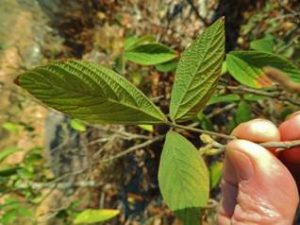
Flemingia grahamiana leaves – Photo by Ian Riddell
Other trees seen, but not mentioned above: Bridelia cathartica (Knobbly Bridelia); Burkea africana (Red Syringa); Cassia abbreviata (Long-tail Cassia); Catunaregam taylorii (spinosa) (Thicket-thorn); Cussonia arborea (Octopus Cabbage tree); Dalbergia nitidula (Purplewood Dalbergia); Dichrostachys cinerea, Chinese-lanterns; Euclea crispa ,Blue-leaved Guarri);
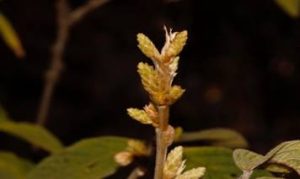
Flemingia grahamiana buds/flowers – Photo by Ian Riddell
Euclea natalensis (Hairy-leaved Guarri); Faurea saligna (Willow Beechwood); Ficus burkei (Common Wild Fig); Flacourtia indica (Governors-plum); Heteromorpha trifoliate (Parsley-tree); Indigofera rhynchocarpa (Hockeysticks); Gymnosporia senegalensis (Confetti Spike-thorn); Ochna puberula (Granite Ochna); Ochna schweinfurthiana (Brick-red Plane); Ozoroa reticulata (Tarberry); Parinari curatellifolia (Mobola-plum), Pavetta schumanniana (Poison Brides-bush); Peltophorum africanum (African Weeping-wattle); Pleurostylia africana (Northern Coffee-pear); Protea angolensis (Northern Protea); Protea welwitschii (Cluster-head Protea); Pseudolachnostylis maprouneifolia (Duiker-berry); Psorospermum febrifugum (Christmas berry); Pterocarpus angolensis (Mukwa); Searsia leptodictya (Rock Rhus); Searsia longipes (Large-leaved Crowberry); Searsia tenuinervis (Curled-leaf Crowberry); Strychnos spinosa (Monkey-orange); Terminalia stenostachya (Rossette Terminalia); Tricalysia niamniamensis (Scaly-bark Jackal-coffee); Vangueriopsis lanciflora, (False Wild-medlar); Vernonia myriantha (Eared Vernonia); Vitex payos (Chocolate-berry) and Ximenia caffra, (Sour-plum).
– Tony Alegria
OUTING TO St George’s College Sunday 18th August 2019
It was a bright crisp sunny morning as seven of us gathered in the car park near the Hall. Mark, Tony and Jan were able to identify most of the trees, Ann and Jim, Jim Drysdale, and Marina made up the rest of the group and later we were joined by Sarah.
St. Georges has a wealth of trees and shrubs planted over many years. We started with an island near the Hall on which was an abundance of plants. We first discussed a bare small tree with soft corky bark and buds about to burst open and some very large dead leaves on the ground – Erythrina latissima (Broad-leaved Coral-tree). The leaflets are ovate and very large, the terminal one measuring 60-300mm x 70-320mm, the lateral ones are smaller. This species occurs in the Eastern districts and then in a swathe diagonally through the country. It is similar in appearance to Erythrina abyssinica (Red-hot-poker Coral-tree) which has smaller leaves and flowers.
The Msasas new leaves were starting to come out. Also on the island were a very large Euphorbia ingens (Giant Euphorbia), a Pittosporum viridiflorum (Cheesewood), an Albizia sp., Lannea discolour (Live-long), Schotia brachypetala (Weeping Schotia), Kigelia africana (Sausage-tree), Dracaena sp., Searsia natalensis (Northern Dune Currant). This species is not now recognized as S. natalensis but has not yet been given a new name.
We then made our way up the hill behind the buildings to the reservoir, noting the trees along the way: Polyscias fulva (Parasol tree), a forest species from the Eastern districts, Ficus sur (Broom-cluster Fig), Tabebuia just starting to bloom with its startling bright yellow flowers. Erythrina lysistemon (Sacred Coral-tree), a large spreading Albizia which was full of pods. Rauvolfia caffra (Quinine tree), with a milky latex, this is used medicinally but is poisonous. Searsia longipes (Large-leaved Rhus), Combretum molle (Velvet-leaved Combretum), Croton sylvaticus (Forest Croton), Julbernardia globiflora (Munondo), Vernonia myriantha (Eared Vernonia) in full flower, Podranea brycei (Zimbabwe creeper), Acacia abyssinica, (Nyanga Flat-top), another tree from the Eastern districts, another very large Combretum molle together with another Searsia (Rhus) natalensis, a handsome Parinari curatellifolia (Mobola-plum), this must have been in situ when the college was built. Other species were: Rothmannia sp., Teclea nobilis (Giant Cherry-orange) and an unidentified climber. Up the path we found Toddalia asiatica (Cockspur-orange), Mark thinks this must have been planted, it belongs to the citrus family and is very prickly with thorns along the leaf. Also seen was Phyllanthus ovalifolius (Potato bush), Carissa edulis, Sapium ellipticum and Phoenix reclinata, an indigenous palm. Ligustrum lucidum (Privet), this is now classified as an alien as its roots sour the soil. It also self-seeds readily. Next we came across Senna singueana which had fallen over but was still flowering. Near the fence was a small Ficus lutea with large leaves and a clump of Strelitzia nicolai, and nearer the buildings we found an Albizia gummifera.
Also seen: Carissa edulis, Tecomaria capensis (Cape Honeysuckle); Pyracantha sp,, Agave sp; Euphorbia cooperi; Kalanchoe madagascariensis (Donkey Ear); Lannea discolor; Erythrina abyssinica; a large Buddleja saligna; Tabebuia sp; Syzygium jambos; Ficus sur; Callistemon viminalis (Bottle Brush); and finally Albizia versicolor (Poisonpod Albizia)
In a courtyard we found a collection of palm trees – Archontophoenix cunninghamiana, three Queen palms, tall and stately, and some Cycas revoluta, well known cycads. Lining the car park below the Chapel, a Brunfelsia (Yesterday, Today and Tomorrow), Mundulea sericea (Cork bush), with greyish bark which is deeply furrowed and corky, together with a Spathodia (Kenya Tulip or Flame tree) and a Fernandoa abbreviata.
On the opposite side of the road were several palms, one with greyish leaves (a Sabal?), a Bamboo palm Chrysalidocarpus lutescens, a Butia odorata, and a very big Phoenix canariensis. (Canary Island palm), an Acacia galpinii in pod, and finally a Koelreuteria paniculata, (Golden Rain tree) with spectacular salmon coloured bracts after the yellow flowers in the summer.
On either side of the road are areas planted to a large variety of trees. These included a Baobab, (Adansonia digitata), Citharexylum spinosum (Lady Chancellor), Kirkia acuminata, Craibia sp. Sterculia quinqueloba, Sterculia africana, Cinnamomum camphora (Camphor tree), Senecio barberera and Terminalia sericea. There was a small Carrot tree (Steganotaenia araliacea) in flower, but dwarfed by a Euphorbia ingens next to a Tabernaemontana elegans (Toad tree) with distinctive fruit, a Ficus abutilifolia, a Erythroxylum emarginatum, a tall and upright Garcinia livingstonia, an Ehretia sp., and finally Balanites maughamii (Torchwood) and Mimusops zeyheri (Red Milkwood) with a milky latex.
We then moved down towards the sports arena, there we saw a Khaya anthotheca, an Acacia tortilis, a Tamboti tree (Spirostachys africana) with poisonous latex. The Dalbergia melanoxylon (Zebra wood) would have been planted. By the tennis courts is a Apodytes dimidiata (Birds-eye) with white flowers. The car park has Schinus terebinthifolius (Brazilian Pepper tree) planted for shade. A large Albizia schimperiana, an Albizia gummifera and a Cussonia arborea are well grown specimens.
This was a most enjoyable morning with plenty of interesting trees and shrubs to think about, thank you Tony and Mark for all your guidance.
– Ann Sinclair
Taken from Tree Life No. 259 September 2001
THE OAKS AT RHODES HOTEL, NYANGA
The night of August 15th [1899] I stayed with Mr. Norris at Rhodes farm, where the cosy dining-room with thick European walls, and a cheerful fire in the grate, made me feel especially comfortable. Dr Carl Peters (1902).
THE ELDORADO OF THE ANCIENTS
It was in 1896 that Cecil John Rhodes first visited the Nyanga district, and so impressed was he with it that he immediately asked his close associate, James Gordon McDonald, to arrange the purchase of up to 100 000 acres (40 500 ha), “and be sure you take in the Pungwe Falls. I would like to try sheep and apple growing”. McDonald was able to carry out his request, and so the Rhodes Inyanga Estate was born, which was eventually bequeathed to the country as a national park.
John Grimmer, one of “Rhodes’s Young Men”, had charge of the estate for a short time, but it was John Norris, one-time valet to Rhodes at Groote Schuur in the Cape, who must be credited with getting the farming and fruit-growing operations started. Norris arrived at the estate late in 1896, and by the middle of 1899 he had established fairly extensive orchards of deciduous fruits – even some citrus, which was quite unsuitable for the local climate.
The farm homestead became the nucleus of today’s Rhodes Hotel, and among the trees planted near the old homestead was an avenue of English oak, Quercus robur. There is no certainty about the planting date, but it was probably during Norris’s time as manager, before Rhodes’s death in 1902 and they were possibly the first oaks in Zimbabwe. Most of them still stand there today and although nearly all have been retarded by the Eucalypts that tower over them from across the road leading to the hotel, the two nearest the hotel reached a respectable size, despite being short-boled. In April 1987 the largest of these was 26 metres tall, with a diameter at breast height of 1.46 metres and a crown spread of 27 metres. The next tree in the avenue was slightly smaller in diameter, but its height and crown width were much the same as those of the first. Sadly, the larger of these two trees was destroyed in a storm in February 1988.
The English oak is out of its element in Zimbabwe and is never likely to reach the great sizes it does in its native habitat, where it sometimes attains a height of 45 metres, with a clear bole of 20 metres. Old, open-grown trees may have massive trunks more than three metres in diameter. To the Druids of Celtic Britain it was a sacred tree, and they gathered mistletoe from its boughs for their religious rites.
Oaks have a long history in mythology – in Ovid’s Metamorphoses there is the account of Philemon and Baucis, who entertained Jupiter and Mercury when everyone else refused them hospitality; their request to die at the same time was granted, and when they were very old Philemon was changed into an oak and Baucis into a linden tree. In Greek mythology oaks were associated with Zeus, the god of thunder, and were believed to be more susceptible than other trees to being struck by lightning – even in Shakespeare’s King Lear there is reference to “oak-cleaving thunderbolts”. Perhaps, as is so often the case, this myth had some real basis in fact, for the oaks would often be the tallest trees around and therefore the most likely to be struck.
-Lyn Mullin
Taken from Tree Life No. 271 September 2002
QAT, KHAT or Catha edulis
On one of the recent Botanic Garden walks we got to discussing the supposed effects of chewing the leaves of Qat, or Catha edulis which we know so well in Zimbabwe. No-one present had experienced any feeling of well-being after munching a leaf and a little research has revealed that perhaps we got it all wrong, expecting too much too soon.
An extract from a very interesting book entitled “People’s Plants” by Ben-Erik van Wyk and Nigel Gericke provides the following information:
Catha edulis (Celastraceae) – ‘Khat’ (Arabic): or ‘Bushman’s tea’ in parts of South Africa.
This small to medium-sized tree is widely distributed along the eastern parts of southern Africa, and further North to East Africa and South Yemen. The use of Catha edulis as a stimulant has been well described in East Africa and in Yemen, but it is not generally known that the plant is used in much the same way in parts of South Africa, The fresh young leaves and adjacent soft stems are chewed for the energy and endurance they give the user, and for freedom from hunger and fatigue during strenuous work and walking in mountainous terrain. The slightly bitter and astringent leaves are chewed and the resulting juices swallowed. A sweet, liquorice-like aftertaste remains, accompanied by thirst. To the uninitiated, the stimulant effects are not immediately apparent, but with experience the unique psychotropic signature of the plant can be appreciated, including remarkable clarity of thought, alertness, a sense of well-being and increased sociability. Some South African users report that chewing fresh leaves was originally learned from the hunter-gatherers – the San. There is some evidence in the literature supporting this. The common English name is Bushman’s tea, and tea is still occasionally brewed from the leaves.
The fresh leaves are chewed, or an infusion of the leaves is taken orally for colds and ‘flu, coughs, asthma, to assist in losing weight and for menstrual cramps. Cold water infusions of the roots or bark are taken for diarrhoea and dysentery, and a root infusion is taken orally for male infertility, and to treat boils.
The stimulating effect of the fresh leaves is due to several phenethylamines, including cathinone which has amphetamine-like properties. Since cathinone is unstable, the preference for the use of fresh leaves can be understood. Prior to the isolation and identification of cathinone, it was believed that cathine (norpseudoephedrine), first isolated from khat in 1930, was the active principle. A synthetic salt of (norpseudoephedrine is widely used as an over-the counter appetite suppressant.
Side-effects of habitual use reported in the literature from Ethiopia, Somalia and Yemen, include the potential for the development of aggressive and paranoid behaviour, personality problems, hypertension, insomnia, constipation, low libido, emaciation and debilitating effects on family budgets. The incidence of these adverse phenomena, if indeed they occur in southern Africa, is unknown.
Cathinone has recently been added to the schedule of illicit drugs in the USA, and fresh Catha edulis itself is sold on the black market in the USA for about $30 a handful. The use of the plant in the USA is believed to be a result of the exposure of soldiers to khat during the U.S. military involvement in Somalia where the plant is widely used as a stimulant.
– Author unknown
TONY ALEGRIA CHAIRMAN


